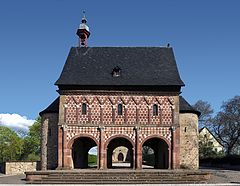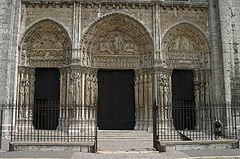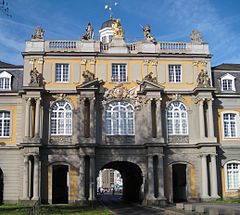Triumphal arch scheme
The terms triumphal arch scheme or triumphal arch motif come from architectural history and describe the three-arched structure of a portal zone, a facade or another component (e.g. the choir section ) based on the ideal of a Roman triumphal arch (e.g. the Arch of Constantine and Septimius Severus Arch , Rome ), which can be found on the arch of the Provençal city of Orange or - in simplified form - also in the Arco Romano of the northern Spanish city of Medinaceli . In very rare cases this motif also appears in the middle level of a facade. It usually consists of a high and wide central arch and two smaller side arches , which are often designed as blind arches . In rare cases, all three arches are dimensioned the same (e.g. Lorsch gate hall ).
According to the understanding of modern architectural theory, the central motif of the triumphal arch scheme is the connection of arch and column position based on ancient models.
history
Since late antiquity (. Eg San Vitale in Ravenna ) and especially since the Carolingian period, Arch schemes are as sovereign-representative architectural elements both sacred - as well as to secular buildings Southern and Central Europe. It experienced a heyday on the portal facades of Gothic cathedrals. In the Moorish architecture of Andalusia and the Maghreb it also appears on palaces (e.g. Alhambra in Granada ), on gate structures (e.g. Bab Mansour in Meknes ) or on mausoleums (e.g. Saadian tombs in Marrakech ).
In the Renaissance period , the motif was brought closer to the Roman models. One of the earliest examples of this is Alberti's west facade of the Tempio Malatestiano in Rimini, which is closely based on the Arch of Augustus in Rimini. In his central work, the Trinità , Masaccio chose the triumphal arch motif as a glorifying frame for the crucifixion scene.
architecture
Churches
The triumphal arch pattern appears on many facades of Romanesque churches in western southern and central Europe, especially in the Charente . The portal zones of most Gothic cathedrals are also designed according to this scheme, whereby it should be noted that the three-part motif is retained even in five-aisled cathedrals (e.g. Cologne Cathedral ; exception: Bourges Cathedral ). The choir part of a three-aisled or a single-nave church with a transept and adjoining apses is also often designed according to this scheme.
Chapter rooms
The entrance areas to the chapter rooms in medieval monasteries are regularly three-arched, and in rare cases five-arched, although only the middle arch is open as access - the side arches, on the other hand, serve as window openings. Overall, however, the underlying triumphal arch scheme remains recognizable.
Royal halls
Not much is known about the design of Carolingian and early medieval royal halls. In the Asturian King's Hall and later Church of Santa María del Naranco (around 850), however, the outward-facing representative effect of a triumphal arch scheme is evident.
Palaces
While triumphal arch motifs do not appear in medieval castle architecture, such schemes have been found in the portal design of many palace and castle buildings in Northern Italy and elsewhere since the Renaissance . At the Palazzo Bevilacqua in Verona a series of this motif appears for the first time on the upper floor; the so-called Venetian windows (e.g. on the Basilica Palladiana in Vicenza ) represent a modification of the triumphal arch scheme.
Gate structures
A triumphal arch scheme can also often be recognized in representative gate structures, such as the Carolingian gate hall in Lorsch or the late baroque Koblenzer Tor in Bonn .
Islamic world
The triumphal arch scheme also appears in the Moorish style of Andalusia and Morocco, which is also influenced by ancient architecture . B. in the Alhambra (14th century) of Granada , in the Saadian tombs (16th century) of Marrakech , at Bab Mansour (around 1720/30) in Meknes and elsewhere. In India it appears in the so-called Teen Darwaza of Ahmedabad (around 1415) or in the portal zone of the Friday mosque there (around 1420).
symbolism
The triumphal arch scheme is considered dignified, representative and demanding of respect and contributes significantly to a dignified and sovereign overall impression of facades or parts of the room designed in this way.






